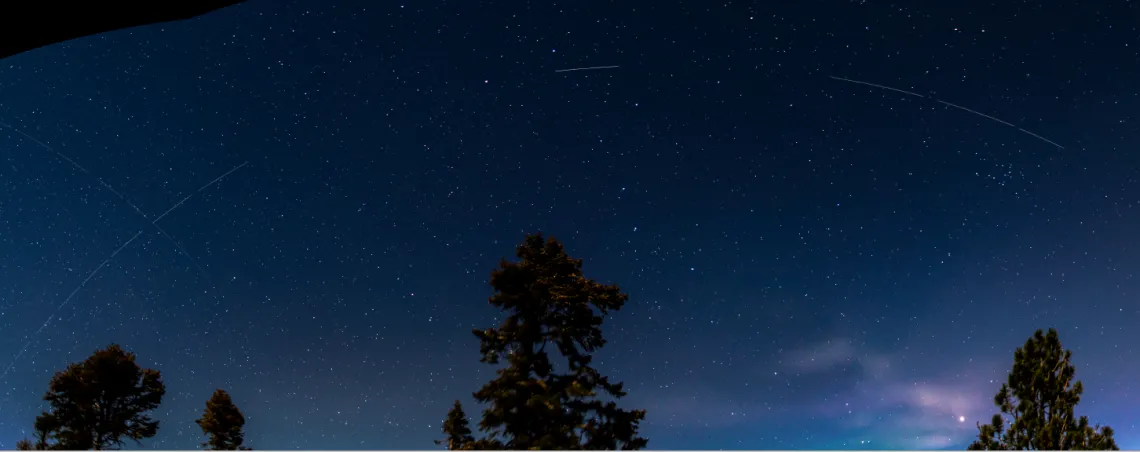Satellite Brightness Threatens Ground-based Astronomy, Research Shows
UArizona faculty and students are part of an international study confirming that deployed satellites like BlueWalker 3 are as bright as the brightest stars seen by the unaided eye and pose a challenge for ground-based astronomy.

The bright streaks drawing an arc across the night sky are caused by the satellite BlueWalker 3.
Ilse Plauchu-Frayn
University of Arizona researchers are part of an international study confirming that deployed satellites like those that provide broadband internet and mobile phone service are as bright as the brightest stars seen by the unaided eye.
The finding could pose challenges to astronomy as nations and companies launch more and more satellite megaconstellations—large networks of bright satellites—into space. The research was published online today in the journal Nature.
“The proliferation of satellite megaconstellations will have a profound impact on ground-based astronomy. Sunlight reflected by these satellites will leave trails on the images taken by existing and upcoming ground-based surveys such as the Vera C. Rubin Observatory in Chile, making it challenging to do astronomical research,” said Vishnu Reddy, professor of planetary sciences at the university’s Lunar and Planetary Laboratory and director of the Space4 Center.
The University of Arizona is a member of the International Astronomical Union Centre for the Protection of the Dark and Quiet Sky from Satellite Constellation Interference.
As satellites in low-Earth orbit move across the sky, they reflect light from the sun back down to Earth, especially during the first few hours after sunset and the first few hours before sunrise. As more companies launch networks of satellites into low-Earth orbit, a clear view of the night sky is becoming rarer.
To better understand how the brightness of megaconstellations could impact astronomers’ ability to observe the dark night sky, the research team studied AST SpaceMobile’s BlueWalker 3, which was launched into low-Earth orbit, about 1,200 miles above Earth, on Sept. 10, 2022.
In November 2022, AST SpaceMobile announced that the satellite, a prototype for the company’s BlueBird satellite megaconstellation, had unfurled the largest telecommunications array, spanning 693 square feet.
As part of the international effort and in partnership with Starizona, a Tucson-based small business, Reddy and two graduate students built a small ground-based sensor with a camera lens that accurately measured the brightness of the BlueWalker 3 satellite.
Astronomers use a scale to measure the brightness of stars in the night sky. The brightness of the stars we can see with an unaided eye ranges from minus 1 at the brightest to 6 at the faintest. Sirius, the brightest star, is minus 1. Planets like Venus can sometimes be brighter--closer to minus 4. Reddy and his UArizona team measured BlueWalker 3 at visual magnitude 0.4 — closer to the brightest stars seen in the night sky.
"We realized that measuring the brightness of really bright objects is very challenging, as the light from them can overwhelm the camera,” said Tanner Campbell, an aerospace and mechanical engineering PhD candidate. He and LPL graduate student Adam Battle developed the software for analyzing the data.
Megaconstellation operators such as SpaceX have been working with the astronomy community to develop mitigation strategies to reduce the brightness of Starlink satellites, Reddy said. The newest generation of Starlink satellites reflect far less light compared to the first generation launched in 2018, he added.
“Megaconstellations are here to stay, and we have to find a way to mitigate their impacts on ground-based astronomy,” said Battle, who was also part of a previous Arizona study focused on measuring the impact of SpaceX’s Starlink megaconstellation. “We currently have more than 4,000 Starlinks and more are being launched every month.”
As a graduate student with the university’s Steward Observatory, Harrison R. Krantz also was part of the consortium that published the paper.
EXTRA INFO
Sangeetha Nandakumar, Siegfried Eggl, Jeremy Tregloan-Reed, et al. The high optical brightness of the BlueWalker 3 satellite, Nature (2023). DOI: 10.1038/s41586-023-06672-7.
Video caption: BlueWalker 3 satellite passes through the skies over Tucson, AZ, on November 12, 2022. To prevent the satellite from saturating the camera, exposure times were kept short. The data was obtained using a device built by University of Arizona researchers in collaboration with Starizona, a local small business.

